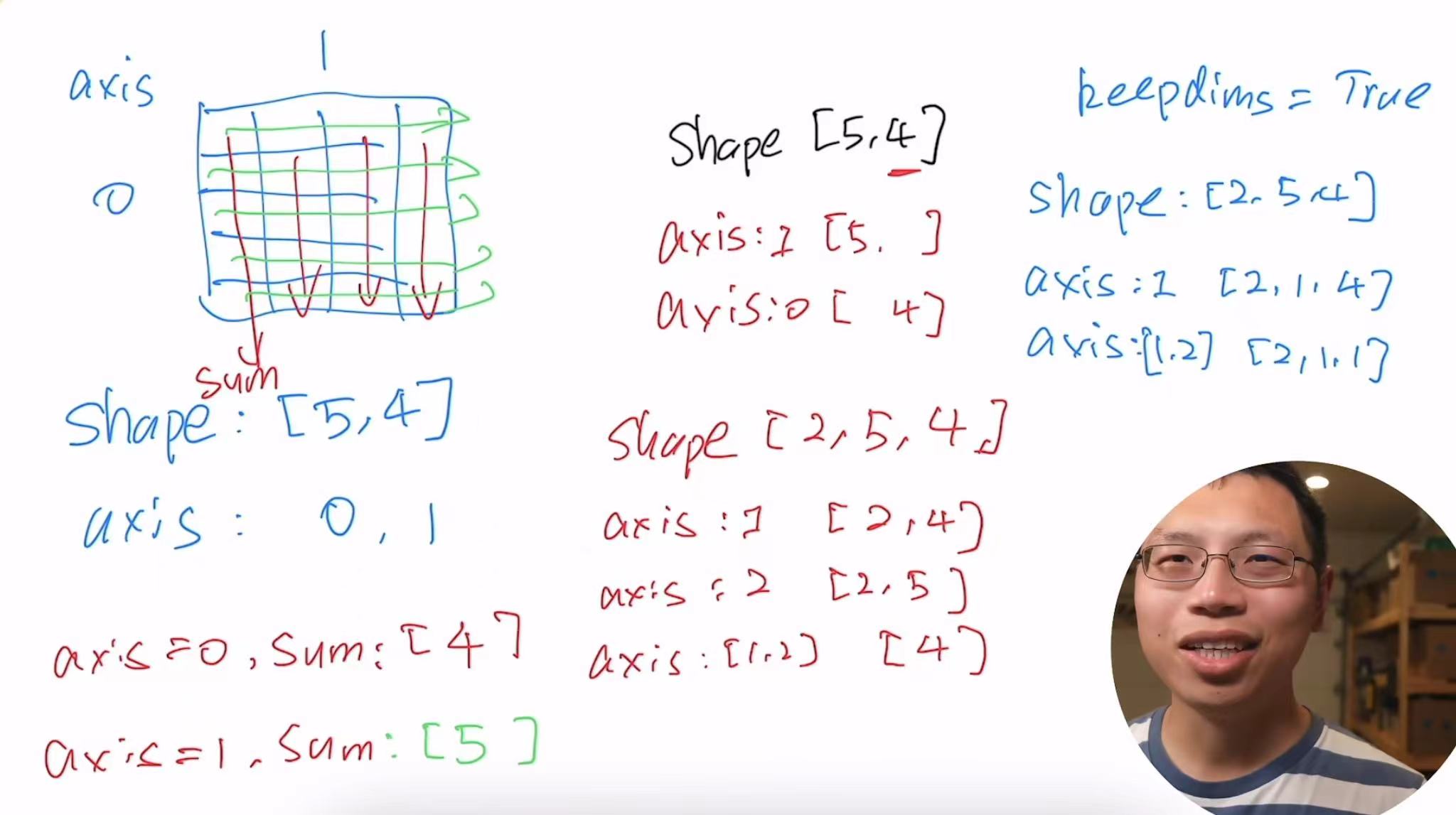标量
x = torch.tensor(3.0)
y = torch.tensor(2.0)
x + y, x * y, x / y, x**y
(tensor(5.), tensor(6.), tensor(1.5000), tensor(9.))向量
你可以将向量视为标量值组成的列表,可以通过张量的索引来访问任一元素
x = torch.arange(3)
x
tensor([0, 1, 2])x[2]
tensor(2)len(x)
3x.shape
torch.Size([3])A = torch.arange(6).reshape(3, 2)
A
tensor([[0, 1],
[2, 3],
[4, 5]])矩阵的转置,对称矩阵等于其转置
A.T
tensor([[0, 2, 4],
[1, 3, 5]])就像向量是标量的推广,矩阵是向量的推广一样,我们也可以构建具有更多轴的数据结构
a = 2
X = torch.arange(24).reshape(2, 3, 4)
a + X, (a * X).shape
(tensor([[[ 2, 3, 4, 5],
[ 6, 7, 8, 9],
[10, 11, 12, 13]],
[[14, 15, 16, 17],
[18, 19, 20, 21],
[22, 23, 24, 25]]]),
torch.Size([2, 3, 4]))给定具有相同形状的任何两个张量,任何按元素二元运算的结果都是具有相同形状的张量
A = torch.arange(6, dtype=torch.float32).reshape(2, 3)
B = A.clone()
A, A + B
(tensor([[0., 1., 2.],
[3., 4., 5.]]),
tensor([[ 0., 2., 4.],
[ 6., 8., 10.]]))两个矩阵的按元素乘法称为哈达玛积(Hadamard product)
A*B
tensor([[ 0., 1., 4.],
[ 9., 16., 25.]])计算其元素的和
x = torch.arange(3, dtype=torch.float32)
x, x.sum()
(tensor([0., 1., 2.]), tensor(3.))指定求和汇总张量的轴
A.shape, A.sum(axis=0).shape,A.sum(axis=0)
(torch.Size([2, 3]), torch.Size([3]), tensor([3., 5., 7.]))
A.shape, A.sum(axis=1).shapeA.shape, A.sum(axis=1).shape,A.sum(axis=1)
(torch.Size([2, 3]), torch.Size([2]), tensor([ 3., 12.])) A.sum(axis=[0,1]),A.sum(axis=[0, 1]) == A.sum()
(tensor(15.), tensor(True))一个与求和相关的量是平均值
A.mean(), A.sum() / A.numel()
(tensor(2.5000), tensor(2.5000))A.mean(axis=0), A.sum(axis=0) / A.shape[0]
(tensor([1.5000, 2.5000, 3.5000]), tensor([1.5000, 2.5000, 3.5000]))A.mean(axis=1), A.sum(axis=1) / A.shape[1]
(tensor([1., 4.]), tensor([1., 4.]))计算总和或均值时保持轴数不变(一个三维的矩阵,按一个维度求和,变成一个二维的矩阵;一个二维的矩阵,按一个维度求和,变成一个一维的向量,但是我们不想丢掉这个维度)
sum_A = A.sum(axis=1, keepdims=True)
sum_A, sum_A.shape,A.sum(axis=1)
(tensor([[ 3.],
[12.]]),
torch.Size([2, 1]),
tensor([ 3., 12.]))通过广播将A除以sum_A(维度必须是一样的)
A / sum_A
tensor([[0.0000, 0.3333, 0.6667],
[0.2500, 0.3333, 0.4167]])某个轴计算A元素的累积总和
A.cumsum(axis=0),A.cumsum(axis=1)
(tensor([[0., 1., 2.],
[3., 5., 7.]]),
tensor([[ 0., 1., 3.],
[ 3., 7., 12.]]))点积是相同位置的按元素乘积的和 torch.dot只能用于一维向量
y = torch.ones(3, dtype = torch.float32)
x, y, torch.dot(x, y)
(tensor([0., 1., 2.]), tensor([1., 1., 1.]), tensor(3.))我们可以通过执行按元素乘法,然后进行求和来表示两个向量的点积
torch.sum(x * y)
tensor(3.)矩阵向量积是一个长度为的列向量,其元素是点积
A.shape, x.shape, torch.mv(A, x), A@x
(torch.Size([2, 3]), torch.Size([3]), tensor([ 5., 14.]), tensor([ 5., 14.]))我们可以将矩阵-矩阵乘法看作是简单地执行次矩阵向量积,并将结果拼接在一起,形成一个矩阵
B = torch.ones(3,3)
torch.mm(A,B)
tensor([[ 3., 3., 3.],
[12., 12., 12.]])范数是向量元素平方和的平方根:$$|\mathbf{x}|2 = \sqrt{\sum^n x_i^2}$$
u = torch.tensor([3.0, -4.0])
torch.norm(u)
tensor(5.)范数是向量元素平方和的平方根:$$|\mathbf{x}|1 = \sum^n |x_i|$$
torch.abs(u).sum()
tensor(7.)矩阵的弗罗贝尼乌斯范数(Frobenius norm)是矩阵元素的平方和的平方根:$$|\mathbf{x}|F = \sqrt{\sum^n\sum_{j=1}^n x_{ij}^2}$$
torch.norm(torch.ones((4, 9)))
tensor(6.)